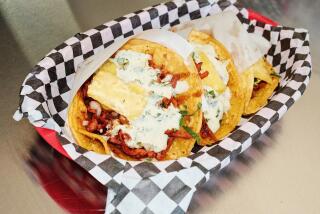
- Share via

Series
Vanessa Anderson is the Grocery Goblin, on a mission to explore neighborhood grocery stores throughout Southern California.
Around the corner from the cavernous aisles — past the frozen hunks of galangal, tinned lychees in their syrupy baths and smooth plastic jugs of peanut oil — sits the sparsely stocked fish counter at LAX-C, the market known to many as Thai Costco.
On the wall behind the counter hang five knives, caked in rust, each mounted on a wooden plank with a date underneath. The oldest one, a cleaver, is from 1998, the same year the store opened.
The knives, like hundreds of collections of ephemera scattered in the corners and on the walls of L.A.’s countless grocery stores, are a museum exhibit hidden in plain sight.


A mural at Vince’s Market in Atwater Village depicts the grocery store in the 1950s. (Vanessa Anderson) At Sahag’s Basturma, Harry Tashjian’s retrospective of photos, baubles and souvenirs hangs facing the cash register. (Vanessa Anderson)
Neighborhood markets often offer something the Broad or the Getty simply cannot. The artifacts within them live and breathe, signs of age like rust and sun stains tethering them to our world in a way that traditional exhibits divorce. Some are carefully tended to, others forgotten.
Whether at LAX-C just north of downtown, Sahag’s in East Hollywood, Vince’s Market in Atwater Village or other shops that are among our most beloved third spaces, these collections tell stories of war, family, recession, embargoes, immigration, spirituality. Always of endurance.
Many small grocers would chuckle in my face if I dared call them curators, let alone gallerists, but they are both. Signage drawn by hand or created with democratized digital tools like Microsoft Paint are folk art. Maps and kitchen equipment are historical artifacts. Murals are fine art.
The knives at LAX-C look like they earned their retirement; the handles are eroded, the blades chipped. One can only imagine what aquatic delights met their timely demise on their watch. I picture a fishmonger with a big, gappy smile and leathered hands of the finest patina, scooping up and smiting crab in one swift motion.

I ask Anna Bholsangngam, one of the store’s managers, in hopes of tracking down this imaginary character, but she can’t remember where the knives came from or how they got there. She’s busy running the biggest Thai wholesaler in Los Angeles, after all.
“They belonged to the person who ran this fish station,” says Bholsangngam, “but I’m not sure who.” One thing she knows for sure is whoever preserved them is long gone.
Relics shrouded in mystery, the knives remind us of a bygone era at LAX-C, when the peeling yellow script that reads “Fresh Fish-Live Fish-Live Lobster-Shrimp-Crab-Clam” was more than half true. The fish is still fresh, but it’s not live. Bholsangngam did away with the fish tanks years ago; it was too expensive to maintain them, and customers weren’t ordering enough variety to justify stocking more than a few species.
Across town in East Hollywood the basturma king of Los Angeles, Harry Tashjian, takes a much-deserved afternoon break at his deli, Sahag’s Basturma. Behind him, facing the cash register, hangs a retrospective.
Unlike Bholsangngam at LAX-C, Tashjian can tell me exactly where each object came from, and as he does so, I begin to piece together his life.

Tashjian is from Armenia, a map of which was given to him, carved in resin-coated wood. The map includes the Republic of Artsakh (which can no longer be found on a map due to its dissolution in January 2024), a breakaway state in Azerbaijan home to a decades-long conflict.

Three brass plaques were given to Tashjian from Lebanon, his father’s home country. Beads and baubles of all shapes and sizes sway on wooden pegs; I thumb each one.
“They’re from Syria, Damascus and Aleppo. I used to buy them from a man from there; now that it’s closed down, I don’t,” he says.
In 1987, Harry Tashjian moved to America, and soon after he took over the shop. Word of his fenugreek-laced basturma — seasoned, dry-cured beef — spread along the San Andreas Fault, attracting customers up and down the coast.
It’s all documented on the wall, photos of Tashjian in the shop, holding his grandkids, arms wrapped around Bourdain and Shaq.
A short drive away at Vince’s Market in Atwater Village, you’ll find a mural resembling a page from an “I Spy” book. Painted by Rafael Escamilla, the brushstrokes portray a shockingly realistic version of Vince’s in the 1950s, how current owner George Magallon remembers it looking when he used to come in as a kid to buy frosty glass bottles of RC Cola. The details reveal themselves in the gumball machine and the choir of canned condensed milk.
“People come all the time to take photos,” Magallon says. “There are very few who still remember what it was like back in ’39, but every once in a while they stop by too.”
More to Read
Eat your way across L.A.
Get our weekly Tasting Notes newsletter for reviews, news and more.
You may occasionally receive promotional content from the Los Angeles Times.











